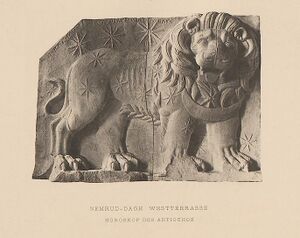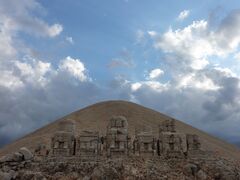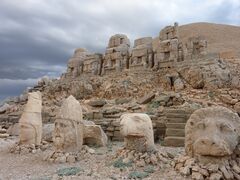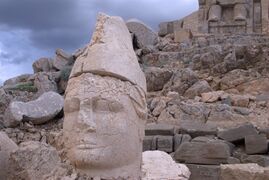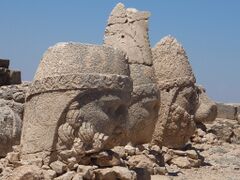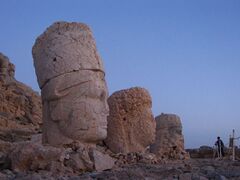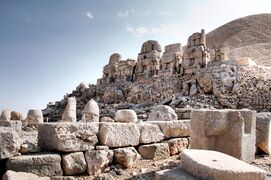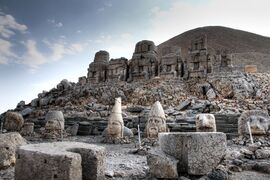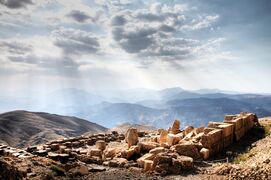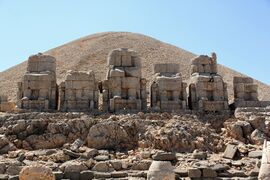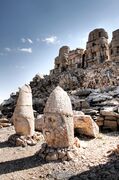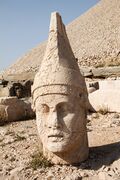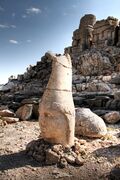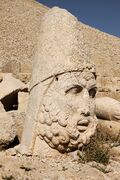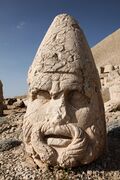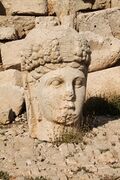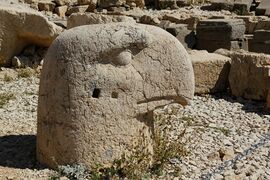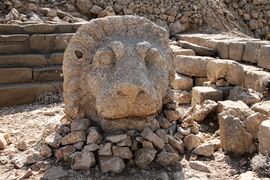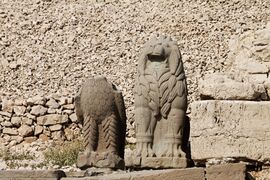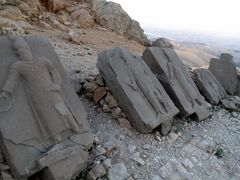جبل نمرود
| Mount Nemrut | |
|---|---|
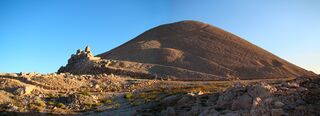 | |
| أعلى نقطة | |
| الارتفاع | 2,134 m (7,001 ft) |
| الإحداثيات | 37°58′54″N 38°44′28″E / 37.98167°N 38.74111°ECoordinates: 37°58′54″N 38°44′28″E / 37.98167°N 38.74111°E |
| الجغرافيا | |
محافظة أدييمن، تركيا | |
| موقع تراث عالمي لليونسكو | |
| Official name | Nemrut Dağ |
| السمات | ثقافي: i, iii, iv |
| مراجع | 448 |
| التدوين | 1987 (11 Session) |
| المساحة | 11 ha |
جبل نمرود أو Nemrud (تركية: Nemrut Dağı؛ كردي: Çiyayê Nemrûdê؛ بالأرمينية: Նեմրութ լեռ) هو جبل ارتفاعه 2,134 متر في جنوب شرق تركيا، يشتهر بقمته التي يوجد فيها عدد من التماثيل الكبيرة المنصوبة حول ما يُعتقد أنها مقبرة ملكية من القرن الأول ق.م. وهي واحدة من أعلى القمم شرق جبال طوروس.
وقد أضافته منظمة اليونسكو كموقع تراث عالمي في 1987. وصف الموقع بالقائمة يقول:[1]
ضريح أنطيوخس الأول (69–34 ق.م.)، الذي حكم كوماگنه، المملكة التي تأسست شمال سوريا والفرات بعد تفكك امبراطورية الإسكندر، is one of the most ambitious constructions of the الفترة الهلينية. The syncretism of its pantheon, and the lineage of its kings, which can be traced back through two sets of legends, اليونانية والفارسية، هي دليل على الأصل المزدوج لثقافة تلك المملكة.
. . . . . . . . . . . . . . . . . . . . . . . . . . . . . . . . . . . . . . . . . . . . . . . . . . . . . . . . . . . . . . . . . . . . . . . . . . . . . . . . . . . . . . . . . . . . . . . . . . . . . . . . . . . . . . . . . . . . . . . . . . . . . . . . . . . . . . . . . . . . . . . . . . . . . . . . . . . . . . . . . . . . . . . .
الموقع والوصف
The mountain lies 40 km (25 mi) north of Kahta، بالقرب من Adıyaman. في 62 ق.م.، الملك أنطيوخس الأول ثيوس من كوماگنه built on the mountain top a tomb-sanctuary flanked by huge statues 8–9-metre high (26–30 ft) of himself, two lions, two eagles and various Greek and Iranian gods, such as Heracles-Artagnes-Ares, Zeus-Oromasdes, and Apollo-Mithras-Helios-Hermes.[2][3] When constructing this pantheon, Antiochus drew heavily from Parthian and Armenian traditions in order to reinvigorate the religion of his ancestral dynasty.[4] These statues were once seated, with names of each god inscribed on them. The heads of the statues at some stage have been removed from their bodies, and they are now scattered throughout the site.
The pattern of damage to the heads (notably to noses) suggests that they were deliberately damaged as a result of iconoclasm. The statues have not been restored to their original positions. The site also preserves stone slabs with bas-relief figures that are thought to have formed a large frieze. These slabs display the ancestors of Antiochus, who Greeks and Persians.[2]
The same statues and ancestors found throughout the site can also be found on the tumulus at the site, which is 49-metre tall (161 ft) and 152 m (499 ft) in diameter. It is possible that the tumulus of loose rock was built to protect a tomb from robbers, since any excavation would quickly fill in.[5] The statues appear to have Greek-style facial features, but Persian clothing and hair-styling.
The western terrace contains a large slab with a lion, showing an arrangement of stars and the planets Jupiter, عطارد and Mars. The composition was taken to be a chart of the sky on 7 July 62 BC.[6] This may be an indication of when construction began on this monument. The eastern portion is well preserved, being composed of several layers of rock, and a path following the base of the mountain is evidence of a walled passageway linking the eastern and western terraces. Possible uses for this site are thought to have included religious ceremonies, owing to the astronomical and religious nature of the monument.
The arrangement of such statues is known by the term hierothesion. Similar arrangements have been found at Arsameia on Nymphaios at the hierothesion of Mithridates I Callinicus, the father of Antiochus.
التاريخ القديم
The religious sanctuary established in Mount Nemrut was part of Antiochus' political program لإحياء التقاليد الفارسية لكوماگنه. In order to do so, he merged and adjusted the political and religious traditions of Cappadocia, Pontus and Armenia. Mimicking the custom of the Mithridatic rulers of Pontus, Antiochus stressed his descent from the Achaemenids and Seleucids, and also claimed the royal legacy of Armenia. One of the essential parts of this identity was the newly established Greco-Iranian pantheon, which was worshipped at specific sanctuaries in Commagene.[7]
التاريخ الحديث
The site was excavated in 1881 by de (Karl Sester), a German engineer assessing transport routes for the Ottomans. After her first visit in 1947, Theresa Goell dedicated her life to the site, starting campaigns in 1954. Subsequent excavations have failed to reveal the tomb of Antiochus. This is nevertheless still believed to be the site of his burial. The statues, all of them "beheaded", have not been restored to their original condition.
موقع تراث عالمي
In 1987, Mount Nemrut was made a World Heritage Site by UNESCO.[8] Tourists typically visit Nemrut during April through October. The nearby town of Adıyaman is a popular place for car and bus trips to the site, and one can also travel from there by helicopter. There are also overnight tours running out of Malatya or Kahta.[9]
معرض
انظر أيضاً
- مدن الشرق الأدنى القديم
- Gods
- List of megalithic sites
- ملكة الجبل—فيلم وثائقي عن حفريات جبل نمرود
المراجع
- ^ "Nemrut Dağ". whc.unesco.org. Retrieved 30 October 2021.
- ^ أ ب Widengren 1986, pp. 135–136.
- ^ Shayegan 2016, p. 13.
- ^ Canepa 2020, p. 203; “Antiochus looked to contemporary Parthian and, especially, Armenian traditions to design his pantheon and reinvigorate his ancestral religion.”
- ^ Hewsen, Robert H. (2001). Armenia: A historical Atlas. p. 42.
- ^ Neugebauer, O.; van Hoessen, H.B. (1959). "Greek horoscopes". Memoirs of the American Philosophical Society. Philadelphia. xlviii: 14–16.
The authors chose that date in preference to 23 July 49 BCE which other researchers prefer, see
Belmonte, Juan Antonio; Gonzales-Garcia, A. César (2010). "Antiochos's hierothesion at Nemrud Dag revisited: Adjusting the date in the light of astronomical evidence" (PDF). J. Hist. Astronomy. 41. - ^ Canepa 2020, pp. 202–203.
- ^ Giorgio Lollino; Andrea Manconi; Fausto Guzzetti; Martin Culshaw; Peter Bobrowsky; Fabio Luino, eds. (2014). Engineering Geology for Society and Territory - Volume 5: Urban Geology, Sustainable Planning and Landscape Exploitation (illustrated ed.). Springer. p. 45. ISBN 9783319090481.
- ^ Patricia Erfurt-Cooper, ed. (2014). Volcanic Tourist Destinations; Geoheritage, Geoparks and Geotourism (illustrated ed.). Springer Science & Business Media. p. 93. ISBN 9783642161919.
المصادر
- Canepa, Matthew (2020). The Iranian Expanse: Transforming Royal Identity Through Architecture, Landscape, and the Built Environment, 550 BCE–642 CE. Oakland: University of California Press. ISBN 9780520379206.
- Goell, Theresa (1957). "The Excavation of the "Hierothesion" of Antiochus I of Commagene on Nemrud Dagh (1953-1956)". Bulletin of the American Schools of Oriental Research. The University of Chicago Press. 147 (Oct.): 4-22.
- Hengel, Martin (1980). Jews, Greeks, and Barbarians: Aspects of the Hellenization of Judaism in the Pre-Christian Period. Fortress. p. 73.
- Shayegan, M. Rahim (2016). "The Arsacids and Commagene". In Curtis, Vesta Sarkhosh; Pendleton, Elizabeth J.; Alram, Michael; Daryaee, Touraj (eds.). The Parthian and Early Sasanian Empires: Adaptation and Expansion. Oxbow Books. ISBN 9781785702082.
- Spawforth, Antony; Eidinow, Esther; Hornblower, Simon, eds. (2014). The Oxford Companion to Classical Civilization. Oxford University Press. p. 542.
- Widengren, G. (1986). "Antiochus of Commagene". Encyclopaedia Iranica, Vol. II, Fasc. 2. pp. 135–136.
- Siliotti, Alberto (2006), Hidden Treasures of Antiquity, Vercelli: VMB, ISBN 88-540-0497-9
- Young, John H. (1964). "Commagenian Tiaras: Royal and Divine". American Journal of Archaeology. Archeological Institute of America. 68, No. 1 (Jan.): 29-34.
- Brijder, Herman A.G. (ed.) (2014), Nemrud Dağı: Recent Archaeological Research and Conservation Activities in the Tomb Sanctuary on Mount Nemrud. Walter de Gruyter, Boston/Berlin, ISBN 978-1-61451-713-9
وصلات خارجية
- Jacobs, Bruno (2011). "NEMRUD DAĞI". Encyclopaedia Iranica.
- Mt. Nemrut
- International Nemrud Foundation
- Commagene Nemrut Conservation and Development Program
]]
- Short description matches Wikidata
- Coordinates on Wikidata
- Articles containing كردي-language text
- Articles containing أرمنية-language text
- مواقع التراث العالمي في تركيا
- كوماگنه
- جبال تركيا
- منتزهات وطنية في تركيا
- 62 ق.م.
- تضاريس محافظة أدييمن
- معالم سياحية في محافظة أدييمن
- تاريخ محافظة أدييمن
- مواقع تاريخية في تركيا
- نمرود
- Important Bird Areas of Turkey
- مواقع أثرية في تركيا



